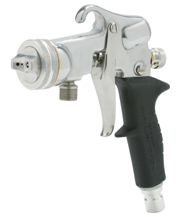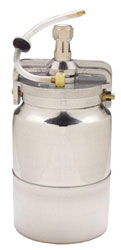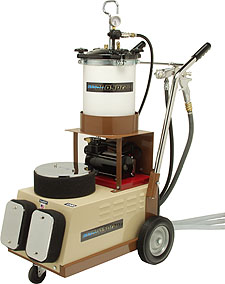
Happy birthday to you, Apollo! That’s right; Apollo Sprayers International, one of the most venerable and respected purveyors of HVLP technology, is celebrating their 40th anniversary. Clearly, there are some good reasons why they’ve been around so long and remain so popular among woodworkers.
“There are lots of competitors out there,” explained Bill Boxer, vice president of global sales and marketing, “and they all attempt to make the best product as they see it. While some companies aim mostly toward the painting and contracting market, we have made woodworking our primary market. As a result, we craft our equipment so as to be the best design and quality for woodworkers.”
Accomplishing that is not a one-way street, but rather a dialogue with woodworkers. “We listen to our customers,” Boxer continued, “and incorporate what they want into our designs. Items like a lighter hose, quick-change fittings and the most comfortable gun on the market are all outgrowths of that feedback.”
Though only recently popular in the United States, both HVLP and Apollo trace their roots to the other side of the Atlantic. Apollo began in Birmingham, England, in 1966, but did not establish itself here in the U.S. until the late 1970s. Since then, it has morphed into two totally independent companies.
The original company was an outgrowth of an air compressor manufacturing company, Bambi Air, that makes silent air compressors. Although Bambi sells equipment under the Apollo brand name today, it is not the same as that sold by the American company of the same name. “Bambi offers a different quality product aimed at lower price point market,” Boxer explained, “and that line is not sold in the U.S. The American-based Apollo company does sell in the U.K, but under the name Alpha Spray.
The company on this side of the Atlantic, Apollo Sprayers International, Inc., was founded by John B. Darroch around 1978. A British expatriate, he decided to introduce the U.S. to what at that time was a little-known technology called “turbo spray systems.” He went around knocking on doors, did demonstrations, did a few trade shows, and put the products into limited distribution. Back then, he was still importing British-made equipment, one model of which looked rather like a flying saucer.

Bill Boxer, who was in the piano business at the time, bought one of those machines around 1983, and had a chance meeting with Darroch in Kansas City. “We hit it off,” Bill told me, “and I remember turning to him and saying ‘This is a fabulous piece of equipment. Why doesn’t everyone have one?’ He replied ‘Well, mate, someone has to get out there and sell it.’ I told him I would, and have been doing just that for the past two decades.”
It was about that same time that John took the equipment to SCAQMD (the South Coast Air Quality Management District) in Los Angeles County. They were busily looking at a variety of technologies to both reduce VOC [volatile organic compounds] emissions and improve transfer efficiency. It was SCAQMD who coined the term HVLP to describe this “High Volume, Low Pressure” turbine technology. “They said we were getting low pressure off of a high volume of air,” described Boxer, “and gave recognition to the technology, putting it, and us, on the map.”
In 1989, Apollo split with England in a disagreement over a spray gun. Feeling the British gun was less than it could be, Apollo designed and made its own. About the same time, they started making the turbine units as well and, by 1990, the separation was complete. Since then, there have been patents and improvements year by year, all aimed at offering consistent high quality without compromising the original promise of true HVLP efficiency.
John B. Darroch stayed with the company until about seven years ago, when he turned it over to his son, John A. Darroch, the current president and CEO. The younger John, a dedicated innovator, has moved the company forward rapidly. HVLP as a technology has become a serious source for air atomizing tools, growing yearly while offering a practical option to compressed air spraying.
Today, Apollo makes two complete lines, one for the domestic market and one for export, and also serve other industries besides woodworkers. One of the most intriguing is UV Sunless Spray Tanning, which uses Apollo HVLP equipment to apply dihydroxyacetone, an FDA-approved chemical that reacts with the skin to develop a natural tan. Think of it as a spray-on “suntan without the sun.”
Apollo’s mission, though, goes beyond merely offering equipment for sale. “There are many offerings that are lumped together under the HVLP rubric,” Boxer explained, “but not all guns are created equal. Some of the guns on the market that tout themselves as HVLP or LVLP (low volume, low pressure) are often little better, as far as transfer efficiency is concerned, than a compressed air gun. We are trying to make ourselves the voice of HVLP in order to bring accurate information about the technology, so woodworkers can make the right choice.” To that end, Apollo has been donating equipment to various woodworking schools and guilds around the country, and has plans to expand that program.
Frankly, there’s a lot to learn about getting good results from this technology. “High quality turbine spraying, like all spraying, involves a lot of variables,” Bill went on, “and one of the most important is fluid tip size. The size of the fluid tip hole controls the amount of finish coming out of the gun, and that in turn affects atomization. You can only atomize a given amount of finish at any one time. Pass too much material through, and you will get a poorer quality finish surface.”
“While some materials can be handled well by a larger tip, others need a smaller one. The right tip size means you will have both maximum delivery and the best quality finish.” To make sure woodworkers get the best possible results, no matter what they choose to spray, Apollo offers five tip sizes ranging from .75 mm to 2.5 mm both separately, and as a complete kit housed in its own carrying case.

In spite of popular belief, HVLP application is not required by law for any hobby woodworker, and many professionals are exempt as well. For example, anyone who sprays less than one gallon of finish per day is exempt from both VOC and transfer efficiency regulations. However, HVLP will save on material consumption by reducing waste and, because it produces less bounceback, your work environment stays cleaner. You’ll also enjoy less overspray on the pieces themselves, and the lower delivery pressure kicks up less dust during spraying than compressed air systems.
For those who consider switching to spray equipment, Bill first asks what coatings they want to apply. “At that point, we can help you find the right equipment. For most woodworkers, a three-stage unit will be the minimum we suggest, and a four-stage is fast becoming the most popular.” Stages correspond to the number of fan blade sets in the unit: the greater the number of stages, the higher the atomizing pressure at the gun tip. Higher atomizing pressures allow you to apply more finish faster with a smoother applied surface, so there’s an advantage to buying the largest number of stages you can afford.
While you can buy direct from Apollo, their products are widely distributed across the country and overseas as well. You can find a distributor near you by clicking the orders and inquiries button on their web site. If one of the woodworking shows comes to your area, chances are you’ll find an Apollo booth there where you can not only see and buy the equipment, but try it out as well. That’s not surprising for a company which contends that their highest priority for growth lies with more consumer education.
“My concern,” Boxer told me, “is to help the end user create what is for him or her the perfect finish. There’s a lot of misinformation about what HVLP is, what it does, and how to use it. My agenda is that I want honest information out there.”







